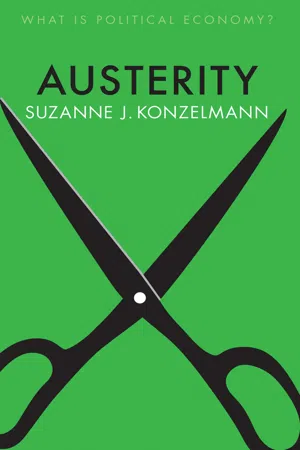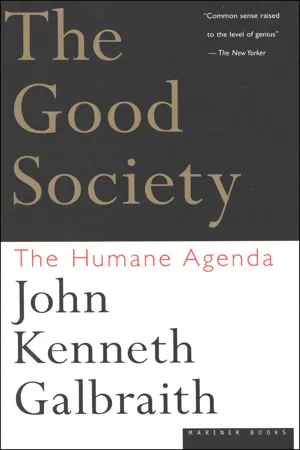Deficits and Debt
Deficits and debt refer to the imbalance between government spending and revenue. A deficit occurs when spending exceeds revenue in a given period, leading to the accumulation of debt. Government debt is the total amount of money owed by the government due to past deficits. These concepts are crucial in understanding the fiscal health and sustainability of a government's finances.
6 Key excerpts on "Deficits and Debt"
- eBook - ePub
- James Gosling, Marc Allen Eisner(Authors)
- 2015(Publication Date)
- Routledge(Publisher)
...A large economy that generates a high national income has more room to run deficits and incur debt than does a much smaller economy. A rapidly growing economy is better positioned to take on rising deficit and debt levels than is a static or declining economy. Deficits and Debt that take a declining share of the GDP place a lessening burden on the economy’s ability to support them. Tables 5.1 and 5.3, respectively, show changes in the federal budget deficit and in debt held by the public as percentages of the GDP over time. Deficit levels following the 2007–2009 recession reached levels that exceeded those of the mid-1980s as a percentage of the GDP. The relative gap was even wider for publicly held debt as a percentage of the GDP, when comparing these two periods. Beyond viewing Deficits and Debt in relation to the size of the economy and its relative growth, several prominent economists suggest that we should rethink the way in which the deficit, and its contribution to debt, is measured. Robert Eisner, for example, argues that several adjustments should be made to the gross deficit. The first adjustment takes into account the surpluses or deficits of state and local governments. Because laws require nearly all state and local governments to balance their budgets, both tend to underestimate revenues and build some leeway into budgeted expenditures, commonly leading to year-end surpluses. State and local budget surpluses either can offset a federal budget deficit when that deficit exceeds their aggregate level or can contribute to a national budget surplus...
...We will also explore the fiscal multiplier because, while stimulus and austerity can influence the direction of change in the sectoral balances, the fiscal multiplier will have a significant effect on the size of that change. Fiscal Deficits and Public Debt Since there is no precise definition of what austerity actually is, it is unsurprising that significant confusion remains. Nor is it just the public that has a poor understanding of the concept; both politicians and the media frequently – and wrongly – use the terms “deficit” and “debt” interchangeably. In 2013, for example, Britain's then Prime Minister David Cameron was publicly rebuked by the UK Statistics Authority for claiming that, by reducing the fiscal deficit (rather than returning it to surplus), his government was “paying down Britain's debts.” At the time, the UK's national debt was in fact rising – which it would, for as long as the budget remained in deficit. We therefore need to start with what government deficits and public debt actually are, how they relate to each other and, eventually, the sectoral balances framework. A government's “primary fiscal deficit” (or surplus) is the difference between its annual expenditure and its revenues; its debt includes not only public debt that has been accumulated over previous years, including interest charges, but also the current year's primary deficit. The deficit, however, can be subdivided into two main components: the “cyclical deficit,” which is built up during a recession and usually eliminated by a surplus resulting from the subsequent recovery, and the “full employment deficit,” which remains relatively consistent across the economic cycle. Both components are determined by fiscal policy, which can include both “discretionary” and “nondiscretionary” elements. Discretionary fiscal policy requires the government to pass new legislation that explicitly changes tax or spending levels, usually in response to political and economic pressures...
- eBook - ePub
- Anthony J. Makin(Author)
- 2016(Publication Date)
- Routledge(Publisher)
...A budget deficit funded through borrowings from the central bank is money financing, which increases the money base. 5. The ‘twin deficits’ hypothesis causally links budget and current account deficits, suggesting that budget deficits affect domestic saving and investment behaviour, and hence international borrowing and foreign debt. 6. Ricardian equivalence proposes that households will reduce private consumption and save more to cover future tax obligations required to repay the public debt that arises from budget deficits. 7. The public debt to GDP ratio will keep rising if budget deficits persist and interest rates exceed the economy’s growth rate. 8. The sustainability of an economy’s public debt affects its creditworthiness and domestic interest rates; if unsustainable, high public debt can precipitate a financial crisis. Appendix A: Inflation-adjusted budget and current account imbalances In the absence of inflation, nominal and real budget outcomes for a closed economy have the same numerical value and are the accounting equivalents of changes in the nominal and real stocks of public debt over time. In an inflationary environment, however, the real purchasing power embodied in public debt held as an asset by bond holders and as a liability of the government falls. Any net decrease (increase) in the inflation-adjusted stock of public debt can be thought of as a measure of the ‘real’ budget surplus (deficit) over that time. An unchanged stock of real public debt means a balanced real budget, as a simple numerical example should make clear...
- eBook - ePub
The Good Society
The Human Agenda
- John Kenneth Galbraith(Author)
- 1997(Publication Date)
- Mariner Books(Publisher)
...7 The Deficit T HERE ARE TIMES in modern history and experience when the enunciation of even the most elementary common sense has an aspect of eccentricity, irrationality, even mild insanity. Such is the risk that is run by anyone in the United States today who challenges the current commitment to reducing and eliminating the government deficit, this being the overall excess of expenditure over income in the public accounts. As just noted, a requirement for a balanced budget recently came within a vote or two, if the states subsequently agreed, of becoming a constitutional mandate, not less as to depth of legal commitment than freedom of speech or the rights of private property. That a given expenditure could increase the deficit has become a decisive objection to it, and this is so even when the most needful of purposes, involving the most needful of citizens, is under discussion—in substantial measure in recent times, especially then. In the American experience certain government expenditures remain outside the public anxiety about the deficit, those for the military, to which I will later come, being the impressive case. Those for the poor most definitely do not. What in the good society is the controlling rule as regards public borrowing and the creation of the public deficit? There is no law or tradition, I will argue, that requires a balanced budget—equal revenues and expenditures on an annual basis. This does not mean, however, that the budget and budget deficits in the modern state can be treated casually; a high measure of intelligence and discretion is always required. What is essential is that the intelligence and discretion be exercised within the relevant framework. Let me be specific, an exceptional tendency on this particular matter. There are three broad categories of public expenditure...
- eBook - ePub
- Anthony J. Makin(Author)
- 2018(Publication Date)
- Palgrave Pivot(Publisher)
...© The Author(s) 2018 Anthony J. Makin The Limits of Fiscal Policy https://doi.org/10.1007/978-3-319-90158-9_4 Begin Abstract 4. Budget Deficits and National Income Anthony J. Makin 1 (1) Griffith University, Gold Coast, QLD, Australia Anthony J. Makin Email: [email protected] The practice, therefore, of contracting debt will almost infallibly be abused in every government. David Hume Abstract This chapter further extends the loanable funds framework to consider the implications for national income that stem from investment and international trade crowding out effects, again with reference to the alternative contexts of closed economy, and open economy with different degrees of international capital mobility. Keywords Investment National income Government spending End Abstract 4.1 Introduction The previous chapter examined different forms of crowding out and public debt escalation that budget deficits cause under alternative assumptions about economies’ openness and degree of international capital mobility. Crowding out of private investment and foreign trade also has direct implications for economies’ national output and income, as can be deduced from the loanable funds framework...
- eBook - ePub
Markets Never Forget (But People Do)
How Your Memory Is Costing You Money--and Why This Time Isn't Different
- Kenneth L. Fisher, Lara W. Hoffmans(Authors)
- 2011(Publication Date)
- Wiley(Publisher)
...The fear the world is dangerously indebted is nothing new. Through history, individually, people run into trouble. Even disastrously! But societally, we carry on. This chapter focuses largely on government debt because it’s government debt people most fear will tank the economy, bring down stocks and leave the country a smoldering ruin. In this chapter, we address: How people fear budget deficits, but history shows it’s the surpluses they should fear. Looking at the long history of government debt helps put it in perspective. Developed world defaults are incredibly rare; emerging world ones are not. Deficits Aren’t Bad, but Surpluses Will Kill You Fill in the blanks. Historically, US federal budget deficits have been ______ for stocks and surpluses _____. If you answered good and then bad, congratulations. You can skip the rest of this section. If you got that backward, read on. Politically, both parties attack deficits. They blame them on their opponents, on the previous administration, on anything but themselves. But if they understood some basic economic fundamentals, maybe they wouldn’t be so keen to deflect blame. Figure 5.1 shows the US federal budget balance as a percent of GDP. I’ve noted relative highs (budget surpluses) and lows (deficits). Then, Table 5.1 shows subsequent 12-, 24- and 36-month returns after relative peaks and troughs. Figure 5.1 US Federal Budget Balance as a Percent of GDP Sources: Global Financial Data, Inc., US Bureau of Economic Analysis as of 03/31/2011. Table 5.1 S&P 500 Returns Following Deficit and Surplus Peaks Sources: Global Financial Data, Inc., US Bureau of Economic Analysis, S&P 500 price returns, as of 03/31/2011. Reflexively, most expect stock returns to do much worse after very big deficits and much better after surpluses. An important lesson: Never reflexively believe anything! History, that useful lab, shows it’s actually the reverse. Twelve months after surplus peaks, stocks returned 1.3% on average...





